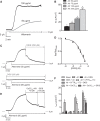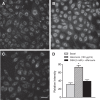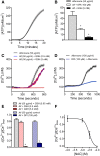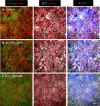Airway epithelial anion secretion and barrier function following exposure to fungal aeroallergens: role of oxidative stress
- PMID: 28446427
- PMCID: PMC5538799
- DOI: 10.1152/ajpcell.00043.2017
Airway epithelial anion secretion and barrier function following exposure to fungal aeroallergens: role of oxidative stress
Abstract
Aeroallergens produced by Alternaria alternata can elicit life-threatening exacerbations of asthma in patients sensitized to this fungus. In this study, the effect of Alternaria on ion transport mechanisms underlying mucociliary clearance and airway epithelial barrier function was investigated in human airway epithelial cells. Apical exposure to Alternaria induced an increase in anion secretion that was inhibited by blockers of CFTR and Ca2+-activated Cl- channels. Stimulation of anion secretion was dependent on Ca2+ uptake from the apical solution. Alternaria exposure also produced an increase in reactive oxygen species (ROS) that was blocked by pretreatment with the oxidant scavenger glutathione (GSH). GSH and the NADPH oxidase inhibitor/complex 1 electron transport inhibitor diphenylene iodonium chloride (DPI) blocked ATP release and the increase in intracellular [Ca2+] evoked by AlternariaAlternaria also decreased transepithelial resistance, and a portion of this effect was dependent on the increase in ROS. However, the Alternaria-induced increase in unidirectional dextran (molecular mass = 4,000 Da) flux across the epithelium could not be accounted for by increased oxidative stress. These results support the conclusion that oxidative stress induced by Alternaria was responsible for regulating Ca2+-dependent anion secretion and tight junction electrical resistance that would be expected to affect mucociliary clearance.
Keywords: ATP release; chloride secretion; intracellular calcium; tight junctions.
Copyright © 2017 the American Physiological Society.
Figures







Similar articles
-
Fungal allergen-induced IL-33 secretion involves cholesterol-dependent, VDAC-1-mediated ATP release from the airway epithelium.J Physiol. 2020 May;598(10):1829-1845. doi: 10.1113/JP279379. Epub 2020 Apr 3. J Physiol. 2020. PMID: 32103508
-
ATP release and Ca2+ signalling by human bronchial epithelial cells following Alternaria aeroallergen exposure.J Physiol. 2013 Sep 15;591(18):4595-609. doi: 10.1113/jphysiol.2013.254649. Epub 2013 Jul 15. J Physiol. 2013. PMID: 23858006 Free PMC article.
-
Airway Exposure to Polyethyleneimine Nanoparticles Induces Type 2 Immunity by a Mechanism Involving Oxidative Stress and ATP Release.Int J Mol Sci. 2021 Aug 23;22(16):9071. doi: 10.3390/ijms22169071. Int J Mol Sci. 2021. PMID: 34445774 Free PMC article.
-
Aeroallergens Induce Reactive Oxygen Species Production and DNA Damage and Dampen Antioxidant Responses in Bronchial Epithelial Cells.J Immunol. 2017 Jul 1;199(1):39-47. doi: 10.4049/jimmunol.1600657. Epub 2017 May 19. J Immunol. 2017. PMID: 28526682
-
Alternaria alternata allergens: Markers of exposure, phylogeny and risk of fungi-induced respiratory allergy.Environ Int. 2016 Apr-May;89-90:71-80. doi: 10.1016/j.envint.2016.01.003. Epub 2016 Jan 28. Environ Int. 2016. PMID: 26826364 Review.
Cited by
-
Oxidative stress, autophagy and airway ion transport.Am J Physiol Cell Physiol. 2019 Jan 1;316(1):C16-C32. doi: 10.1152/ajpcell.00341.2018. Epub 2018 Oct 10. Am J Physiol Cell Physiol. 2019. PMID: 30303690 Free PMC article. Review.
-
Inducible expression of heat shock protein 20 protects airway epithelial cells against oxidative injury involving the Nrf2-NQO-1 pathway.Cell Biosci. 2020 Oct 19;10:120. doi: 10.1186/s13578-020-00483-3. eCollection 2020. Cell Biosci. 2020. PMID: 33088476 Free PMC article.
-
A scoping review: What are the cellular mechanisms that drive the allergic inflammatory response to fungal allergens in the lung epithelium?Clin Transl Allergy. 2023 Jun;13(6):e12252. doi: 10.1002/clt2.12252. Clin Transl Allergy. 2023. PMID: 37357550 Free PMC article.
-
ATP functions as a primary alarmin in allergen-induced type 2 immunity.Am J Physiol Cell Physiol. 2023 Nov 1;325(5):C1369-C1386. doi: 10.1152/ajpcell.00370.2023. Epub 2023 Oct 16. Am J Physiol Cell Physiol. 2023. PMID: 37842751 Free PMC article. Review.
-
Protective role of CFTR during fungal infection of cystic fibrosis bronchial epithelial cells with Aspergillus fumigatus.Front Cell Infect Microbiol. 2023 Aug 23;13:1196581. doi: 10.3389/fcimb.2023.1196581. eCollection 2023. Front Cell Infect Microbiol. 2023. PMID: 37680748 Free PMC article.
References
-
- Adhikari A, Reponen T, Lee SA, Grinshpun SA. Assessment of human exposure to airborne fungi in agricultural confinements: personal inhalable sampling versus stationary sampling. Ann Agric Environ Med 11: 269–277, 2004. - PubMed
-
- Boitano S, Flynn AN, Sherwood CL, Schulz SM, Hoffman J, Gruzinova I, Daines MO. Alternaria alternata serine proteases induce lung inflammation and airway epithelial cell activation via PAR2. Am J Physiol Lung Cell Mol Physiol 300: L605–L614, 2011. doi:10.1152/ajplung.00359.2010. - DOI - PMC - PubMed
-
- Boncoeur E, Criq VS, Bonvin E, Roque T, Henrion-Caude A, Gruenert DC, Clement A, Jacquot J, Tabary O. Oxidative stress induces extracellular signal-regulated kinase 1/2 mitogen-activated protein kinase in cystic fibrosis lung epithelial cells: potential mechanism for excessive IL-8 expression. Int J Biochem Cell Biol 40: 432–446, 2008. doi:10.1016/j.biocel.2007.08.013. - DOI - PubMed
MeSH terms
Substances
Grants and funding
LinkOut - more resources
Full Text Sources
Other Literature Sources
Miscellaneous

